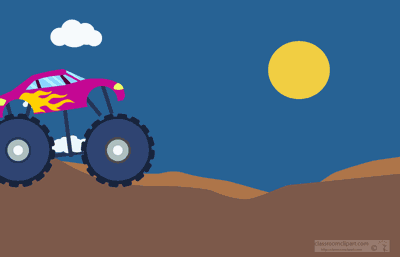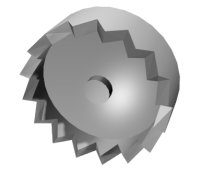Gear
|
|
A gear is a toothed wheel designed to transmit torque to another gear or toothed component. The teeth of a gear are shaped to minimize wear, vibration and noise, and to maximize the efficiency of power transmission.
Different-sized gears are often used in pairs for a mechanical advantage, allowing the torque of the driving gear to produce a larger torque in the driven gear at lower speed, or a smaller torque at higher speed. The larger gear is known as a wheel and the smaller as a pinion. This is the principle of the automobile gearbox, allowing selection between various mechanical advantages. As a gearbox is not an amplifier or a servo system, conservation of energy requires that the amount of power delivered by the output gear or shaft will never exceed the power applied to the input gear, regardless of the gear ratio. There is actually some loss of power due to friction.

The most common type of gear wheel, spur gears, are flat and have teeth projecting radially and in the plane of the wheel, "straight-cut gears". These gears can be fitted only to parallel axles. Helical gears offer a refinement over spur gears. The teeth are cut at an angle, allowing for more gradual, hence smoother meshing between gear wheels, eliminating the whine characteristic of straight-cut gears. A disadvantage of helical gears is a resultant thrust along the axis of the gear, which needs to be accommodated by appropriate thrust bearings, and a greater degree of sliding friction between the meshing teeth, often addressed with specific additives in the lubricant. Double helical gears, also known as herringbone gears, overcome this problem by having teeth that are 'V' shaped. Each gear in a double helical gear can be thought of as two standard, but mirror image, helical gears stacked. This cancels out the thrust since each half of the gear thrusts in the opposite direction. They can be directly interchanged with spur gears without any need for different bearings. Beveled gears have angled teeth, allowing torque to be transmitted between non-parallel but intersecting axles. Four beveled gears in a square make a differential gear, which can transmit power to two axles spinning at different speeds, such as those on a cornering automobile.
If the axles are skewed, that is, non-intersecting, then a worm gear can be used. This is a gear that resembles a screw, with parallel helical teeth, and mates with a normal spur gear. The worm gear can achieve a higher gear ratio than spur gears of a comparable size.
A sector gear is merely a segment of a spur gear, such as one half or one quarter of the circumference, but still attached to the axle in the normal fashion. Such a gear will obviously operate normally as long as the gear with which it meshes does not drive off the edge of the sector, for instance in a worm and sector automotive steering gear or its descendant the recirculating ball. It is useful for saving space and weight when only limited movement is necessary rather than the full 360 degrees of rotation.
Torque can be converted to linear force by a rack and pinion. The pinion is a spur gear, and mates with a toothed bar or rod that can be thought of as a spur gear with an infinitely large radius of curvature. Such a mechanism is used in automobiles to convert the rotation of the steering wheel into the left-to-right motion of the tie rod(s).
A crown gear or contrate gear is a special form of bevel gear which has teeth at right angles to the plane of the wheel; it meshes with a straight cut spur gear or pinion on a right-angled axis to its own, or with an escapement such as found in mechanical clocks.
Simple gears suffer from backlash, which is the error in motion that occurs when gears change direction, resulting from hard to eliminate manufacturing errors. When moving forwards, the front face of the drive gear tooth pushes on the rear face of the driven gear. When the drive gear changes direction, its rear face is now pushing on the front face of the driven gear. Unless deliberately designed to eliminate it, there is slight 'slop' in any gearing where briefly neither face of the driving gear is pushing the driven gear. This means that input motion briefly causes no output motion. Assorted schemes exist to minimize or avoid problems this creates.
In some machines it is necessary to change the gear ratio to suit the task. There are several ways of doing this. For example:
- Manual transmission ('stick shift' in the US)
- automatic gearbox
- derailleur gears which are actually sprockets in combination with a roller chain
- hub gears (also called epicyclic gearing or sun-and-planet gears)
- continuously variable transmission
- transmission (mechanics)
Friction and wear between two gears is highly dependent on the profile of the teeth. The tooth form used for most applications is involute but there are other tooth forms such as cycloidal (used in mechanical clocks) or rack (used in automobile steering).


